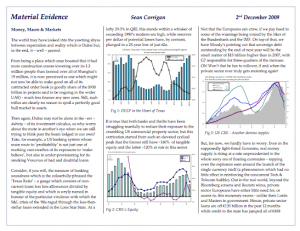Doubts about post-crisis monetary policy are finding their way into the mainstream with increasing regularity. What tipped the balance? Two main things, I think.
First, it’s getting tough to argue that it’s working. After eight long years central banks are still mollycoddling their fragile economies and overall indebtedness keeps on growing. Second, faced with this puzzle, rather than re-examine their premises central banks have tended to double down with policies like NIRP, extending QE to corporate bonds and equities as well as canvassing even more radical moves like banning cash and cranking up the helicopters.
None of it’s a good look. Happily, scrutiny of these various idiocies is becoming ever more common.
Central banks and their intellectual handmaidens have owned this conversation for a long time. The weakness of their underlying rationale went mostly unexamined because of the deeply embedded belief that they had a handle on things. Until very recently, the internal contradictions and lack of an endgame never seemed to be considered, except by a heterodox fringe.
So what are these internal contradictions?
Ever since the crisis, official policy has aimed to return growth to its previous path, to close the output gap. Little consideration was given to the fact that a good deal of that earlier growth was due to continually expanding credit, or to the possibility that by 2007 this massive, and inherently unrepeatable, cycle may have hit its natural limits.
Borrowing today means repayments, with interest, tomorrow. Unless the borrowed funds are successfully invested in productive capacity, they will unavoidably constrain the borrower for some time to come. Growth based on credit, therefore, is necessarily suspect, the more so the higher the level of existing credit. In trying to force this machinery to get under way again, central banks are working against themselves. As Mervyn King put it in his recent book[1]:
“Monetary stimulus via low interest rates works largely by giving incentives to bring forward spending from the future to the present. But this is a short-term effect. After a time, tomorrow becomes today. Then we have to repeat the exercise and bring forward spending from the new tomorrow to the new today. As time passes, we will be digging larger and larger holes in future demand. The result is a self-reinforcing path of weak growth in the economy.”
Which pretty much describes the current state of affairs. In this cool light, the favoured analogies of “kickstarting” the economy, or helping it “to reach takeoff speed”, can be seen as the empty dreams they are.
Whether suppressing interest rates indirectly via QE or directly via interest-rate policy, central banks are still chasing this same broad goal of pulling forward spending from the future[2]. With QE the hope is that those investors left holding cash after central bank operations will reinvest it in slightly riskier securities (say corporate bonds rather than Treasuries), and that a chain reaction will unfold as successive recipients of cash move further out the risk and duration curve. The resulting wealth effect, it’s hoped, will cause at least some to throw caution to the wind and spend, or invest, with abandon.
There are two flaws with this plan. To begin with, the odds that spending will be done wisely under such perverse encouragement and distorted price signals[3] aren’t great. Consider the ongoing buyback boom, for example. Even more critically however, as King noted above, there’s no realistic exit plan. While no one may know exactly where the limits are on various credit ratios, it takes a particular kind of fool to suggest they don’t exist.
Despite central bankers’ heroic efforts, or more accurately because of them, credit growth forged on post-crisis. Though a touch dated, McKinsey’s Feb 2015 “Debt and (Not Much) Deleveraging”[4] still provides the best overview of our continuing magical mystery tour in money and credit. From 2007-2014, global credit rose from US$142 trillion (269% of GDP) to US$199 trillion (286% of GDP). As they said, not much sign of deleveraging there, beautiful or otherwise. By the way, of that growth 44% was government debt and a (truly astonishing) 36% was in China.
As an amusing final aside, Krugman, whose recent review of King’s book in the NYRB[5] brought the quote to my attention, is dubious about the argument. Hardly surprising, given his strong commitment to aggressive monetary intervention. He “suspect[s] that this is exactly the kind of situation in which words alone can create an illusion of logical coherence that dissipates when you try to do the math”. Maybe, but the logic does seem rather straightforward. That Krugman chooses not to argue with King’s contention using words (which, after all, he is rather good at) is perhaps telling.
______________________________________________________
1 Mervyn King, “The End of Alchemy: Money, Banking, and the Future of the Global Economy”
2 Quite why they think lower rates would achieve that end has long puzzled me, particularly when it comes to households; after all, their holdings of financial assets, on which they generally earn interest, vastly exceed their liabilities.
3 Any more than they are under the many and alluring inducements of a full on credit boom. So, in addition to the malinvestments piling up in recent years are those accumulated pre-crisis and still lingering thanks to the tender ministrations of central banks and officialdom more generally.
4 McKinsey & Co, “Debt and (Not Much) Deleveraging”
5 Paul Krugman, “Money: The Brave New Uncertainty of Mervyn King”

